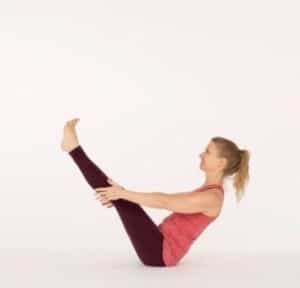Uncover the physiological, psychological, and neurological wonders of yoga’s therapeutic embrace. As B.K.S. Iyengar said, “Yoga teaches us to cure what need not be endured and endure what cannot be cured.”In a world of constant stress and pressure, the ancient practice of yoga has been a powerful tool for not only physical fitness but holistic well-being. Our body and mind are connected. Thus our mental and emotional states are reflected in our bodies. In this blog, we will dwell on the science behind yoga therapy and how somatic therapy helps you heal chronic traumatic illnesses.
Struggling to manage your emotions and find peace?

What exactly is Yoga Therapy?
The International Association of Yoga Therapists defines Yoga therapy as “Yoga therapy is the process of empowering individuals to progress toward improved health and well-being through the application of the teachings and practices of Yoga”. The word “yoga” comes from the root word “yuj,” which means “to yoke” or “to bind”.Yoga therapy includes some mindful activities like physical postures and movement (asanas), breathing exercises (pranayama) and meditation/relaxation (dhyana). The practice uses movement, mindfulness, meditation, relaxation and breathing exercises to help you relax, relieve stress and manage underlying conditions or symptoms. It integrates the mind, body and spirit.
Role of a Yoga Therapist
Yoga therapists are skilled workers who prescribe different yoga poses, breathing techniques and exercises to clients to help them get enormous health benefits. You must be wondering if a yoga teacher or yoga therapist is the same. The answer is No! A yoga teacher typically instructs group classes, focusing on guiding students through yoga postures and breathing exercises. A yoga therapist, on the other hand, works more individually with clients to address specific health concerns through tailored yoga practices, often incorporating therapeutic principles. While both roles involve sharing yoga, the therapist’s focus is on using yoga as a tool for holistic health and healing.

Yoga Poses in Yoga Therapy
The integration of physical postures with breath awareness and mindfulness contributes to the therapeutic effects of yoga practice. Some of the prominent yoga poses are –
- Mountains pose (tadasana)
- Downward dog(adho mukha shavasana)
- Virabhadrasana
- Tree pose (Vraksasna)
- Triangle pose(trikonasana)
- High lunge
- Bridge pose
- Seated spinal twist
- Baby cobra
- Child pose(Balasana)
- Easy seat (Sukhasana)
- Staff pose(Dandasana)
- Corpse pose(Savasana)
- Thread the needle(Parsava Balasana)

How do Yoga postures help Improve Physical and Mental health?
- Bridge – Bandha Sarvangasana The Bridge yoga pose is a great front hip joint opener, it also strengthens your spine, opens the chest, and improves your spinal flexibility in addition to stimulating your thyroid. This pose brings many benefits to your body, such as relief from stress, anxiety, and insomnia and it can help with depression
- Downward Dog – Adho Mukha Svanasana
The Downward Dog yoga pose lengthens and decompresses the spine, stretches the hamstrings, strengthens your arms, flushes your brain with fresh oxygen and calms your mind.
- Child Pose – Balasana
The Child Pose is a resting pose useful to relieve neck, back and hip strain. While in the posture you should have slow regulated breath; extended arms; and resting hips and your forehead should be touching the mat. You can always return to this pose as it is one of the most restorative and calming poses.
- Easy yoga pose Easy Pose – Sukhasana
The Easy Pose may seem like an easy pose but it has many benefits for the body. For example, it is a hip opener, it is calming, and it eases the menstrual pain for women in addition to lowering the level of anxiety (while doing the posture make sure your spine is straightened).
- Warrior 1 – Virabhadrasana I
The Warrior I is a great pose for those of you who have had a hectic day at work and just need to relax your body and mind. While in this pose you are strengthening your legs, and opening your chest and shoulders, movements which we usually don’t do throughout our day, but they are necessary for a good posture and peaceful mind. The effects of this posture are tremendous: it strengthens the muscles of your knees and feet, stretches your shoulders and spine, and it improves your focus.
- The Warrior II yoga pose– also strengthens your legs and arms, opens your chest and shoulders, and it contracts your abdominal organs. Your breath needs to be regulated, your focus should be on the expansion of your arms which will help you to improve your patience. Keep yourself elevated rather than collapsing with your hips – don’t allow gravitation to pull you down. Stay strong.
- Triangle – Trikonasana
The Triangle is one of those postures that brings to your body many benefits. For example, it improves the flexibility of your spine; helps with the alignment of your shoulders; it relieves back pain and stiffness in the neck area, but don’t forget you need to practice each posture on the left and right side – balancing your postures is very important. With the practice of this posture, you will notice many improvements, especially for your posture.
- Four-Limbed Staff – Chaturanga
The Four-Limbed Staff yoga pose strengthens your arms, wrists and abdomen. It is also a good preparation pose for more challenging arm balancing poses.
- Chair – Utkatasana
The Chair yoga position tones your leg muscles and strengthens your hip flexors, ankles, calves and back. It stretches the chest and shoulders. It reduces symptoms of flat feet and it stimulates your heart, diaphragm, and abdominal organs.
- The Tree Pose – Vrksasana
The Tree yoga pose may seem like another easy posture but it is not a resting asana. Your back should be aligned property (extended), your hips should be at one level, and since your stability depends on the distribution of your weight on your standing leg ensure you do so while maintaining and improving your balance.
- Boat pose Boat – Navasana
The Boat yoga requires one to be stable (as a boat) which means, straight back, chin looking forward, while knees and arms are locked. This is not an easy posture. Through it, you build strong abdominal and core strength.
- The crow pose – Bakasana
The Crow yoga pose strengthens the wrists, forearms, and abdomen while also stretching the hamstring. Balance is crucial for this pose.
- Arm Balance Pincha Mayurasana
The arm balancing yoga pose is an advanced pose. This particular one helps you with blood flow throughout your body; it calms your mind and it strengthens your arms.
- Corpse pose Corpse – Savasana
The Corpse yoga pose is one of the most important postures. It is meant to rejuvenate your mind and body after practice while also allowing you to shift your attention to your inner self. The benefits: lowering your blood pressure, calming you and allowing your body to absorb all of the benefits you worked out for.
- King Dancer pose King Dancer – Natarajasana
The King Dancer yoga pose strengthens your legs, and improves balance and core strength while also stretching your shoulders and improving your focus. It is one of the most graceful asanas.
What is a Yoga Class?
A yoga class is a group or individual session where participants practice various physical postures, breathing exercises, and meditation to promote physical, mental, and spiritual well-being. Classes can range from gentle and relaxing to more intense and dynamic.
How to find a Yoga Therapist?
To find a yoga therapist, go to the IAYT member directory and search for therapists in your location, or ask your local yoga teachers or peer support groups for recommendations for teachers who work either in-person or online. Yoga therapy is first and foremost yoga—a long-established, holistic discipline that acknowledges the multidimensional nature of the human being.
Working with a yoga therapist, either one-on-one or in a group, can be a transformational approach to health and healing. Approaches vary widely, however, as does the education, training, and experience of yoga therapists.
We encourage you to review qualifications and local reputations carefully. All qualifications presented in member profiles in IAYT’s online member directory are self-reported. Presence in the directory does not imply endorsement by IAYT. Because a sanctioned definition of “yoga therapist” does not yet exist, IAYT encourages members who describe themselves as a yoga therapist to provide in their professional profiles a summary of what they do, including special skills or areas of expertise, along with information on their training, general education, and experience.
What is IAYT?
The International Association of Yoga Therapists (IAYT) is a professional organization that focuses on promoting the field of yoga therapy. It provides resources, education, and networking opportunities for yoga therapists and those interested in the therapeutic applications of yoga. Yoga therapists often undergo specialized training and may hold certifications from organizations such as the International Association of Yoga Therapists (IAYT). Yoga Therapists work in collaboration with healthcare professionals to complement conventional medical approaches and support individuals on their journey to improved health and well-being. IAYT-certified yoga therapists, or C-IAYTs, are highly trained professionals who meet or exceed our established international standards
What Does Yoga Therapy Include?
- Asana (Physical Postures): Tailored yoga poses are prescribed to address specific health concerns, improve flexibility, and promote overall physical well-being.
- Pranayama (Breathing Exercises): Breathwork is used to enhance respiratory function, reduce stress, and improve overall mental clarity and focus.
- Meditation and Mindfulness: Practices that cultivate mindfulness and meditation are integrated to promote mental health, stress reduction, and emotional well-being.
- Relaxation Techniques: Yoga therapy often includes guided relaxation and stress reduction methods to help individuals release tension and achieve a state of calm.
- Lifestyle Recommendations: Yoga therapists may offer guidance on lifestyle modifications, including diet, sleep, and daily routines, to support overall health.
- Ayurvedic Principles: Some yoga therapy practices incorporate Ayurvedic principles, addressing imbalances in the body’s constitution through personalized recommendations.
- Yoga Nidra: A form of guided meditation and deep relaxation that can promote better sleep, reduce anxiety, and enhance overall mental well-being.
- Mind-Body Connection: Yoga therapy emphasizes the connection between the mind and body, encouraging individuals to become more aware of their physical and mental states.
- Personalized Approach: One of the strengths of yoga therapy is its adaptability. Practices are tailored to individual needs, considering factors such as health conditions, abilities, and goals.
- Therapeutic Relationship: Yoga therapists work in collaboration with clients, creating a supportive and empowering therapeutic relationship to facilitate the healing process.
Effects of Yoga
The word “yoga” comes from the root word “yuj,” which means “to yoke” or “to bind.”
Some effects of yoga are-
- Better posture – Regular practice of yoga asanas (postures) increases flexibility by stretching and lengthening muscles
- Stress reduction – Breathing exercises (pranayama) and mindful meditation help reduce stress.
- Increased strength – Many yoga poses require the engagement of various muscle groups, contributing to overall strength development.
- Enhanced Balance and Coordination: Yoga poses often involve balancing, which helps improve coordination and stability.
- Mental Clarity and Focus: Meditation and mindfulness practices in yoga contribute to improved concentration and mental clarity
- Emotional Well-Being: Yoga encourages self-awareness and emotional regulation, fostering a positive impact on mental health.
- Better Sleep: Regular yoga practice has been associated with improved sleep quality and reduced insomnia symptoms.
Somatic Therapy
The term somatics is derived from the Latin word soma, meaning “the living body” or “embodied”.Semantics is a movement therapy, a way of re-educating the way our brain senses and moves the muscles. Somatic yoga therapy is a therapeutic system of movement that addresses patterns of contraction, stress, and tension that have become normalized within the nervous system. These patterns develop in response to both acute and chronic stressors, repetitive use, and/or prolonged periods in a particular position. Somatic therapy is a holistic therapeutic approach that emphasizes the connection between the mind and body. It recognizes the significance of bodily sensations, movements, and experiences in understanding and addressing psychological issues. Somatic therapists work with clients to explore and release physical tensions, trauma, or stress held in the body, aiming to promote overall well-being.
Health Benefits of Somatic Therapy
Somatic therapy has enormous health benefits.
- It helps heal chronic or acute trauma and PTSD (Post Traumatic Stress Disorder).
- It also improves mobility, strength and posture.
- Reduces neuromuscular pain and symptoms related to chronically tight muscles such as headaches, frozen shoulder, and breathing difficulties.
Health benefits of Yoga therapy
Yoga therapy offers a range of health benefits, including:
- Stress Reduction – Yoga therapy incorporates relaxation techniques and mindfulness, reducing stress and promoting a sense of calm.
- Improved Flexibility and Strength – Physical postures (asanas) in yoga therapy help enhance flexibility, balance, and strength.
- Pain Management – Yoga therapy can be effective in managing chronic pain conditions, such as lower back pain or arthritis, through targeted movements and stretches.
- Mental Health Support – Practices like meditation and breathing exercises contribute to improved mental health, reducing symptoms of anxiety and depression.
- Enhanced Respiratory Function – Breathing exercises (pranayama) in yoga therapy can improve lung capacity and respiratory function.
- Balance and Coordination – Yoga therapy often includes exercises that enhance balance and coordination, which can be especially beneficial for older adults.
- Improved Sleep – Regular yoga therapy has led to better sleep patterns and improved sleep quality.
- Mind-Body Connection – Yoga therapy fosters awareness of the mind-body connection, promoting holistic well-being and self-care.
- Cardiovascular Health – Certain yoga practices, when combined with healthy lifestyle choices, may contribute to improved cardiovascular health.
The Science Behind Yoga Therapy
Originating in ancient India, yoga has gained worldwide popularity not only as a physical exercise but also as a holistic approach to wellness.
While the spiritual and philosophical aspects of yoga are well known, there is growing interest in the scientific principles behind its benefits.
This article explores the physiological, psychological and neurological aspects that contribute to the science behind yoga.
1. Physiological effects of Yoga Therapy
- Respiration and oxygenation: Yoga emphasizes conscious breathing techniques, such as pranayama, which strengthen the breath. Deep, controlled breathing increases oxygen consumption, improves overall lung capacity and promotes better oxygenation of the body and tissues.
- Flexibility and Strength: Asanas, or yoga poses, focus on flexibility and strength. Regular exercise improves muscle tone, flexibility and joint mobility, which contributes to better overall physical health.
- Cardiovascular Benefits: Dynamic forms of yoga, such as Vinyasa, can act as a cardiovascular workout. Yoga has been linked to heart health, including lowering blood pressure and reducing the risk of cardiovascular disease.
2. Psychological benefits of Yoga Therapy
- Reducing stress: Mindfulness in yoga encourages living in the present moment, reducing stress and anxiety. Techniques such as meditation and deep relaxation activate the parasympathetic nervous system and promote a calm state.
- Mind-Body Connection: Yoga promotes a strong mind-body connection that increases awareness of physical sensations and emotions. This heightened awareness promotes emotional regulation and a better understanding of the human and mental state.
- Better sleep quality: Regular yoga practice has been linked to better sleep habits. Relaxation techniques and controlled breathing help relieve insomnia and promote restful sleep.
3. Neurological effects of Yoga Therapy
- Brain plasticity: Yoga has been shown to induce neuroplasticity in the brain and the ability to reorganize and adapt. Mindful movement and meditation can affect changes in neural pathways that improve cognitive function.
- Stress reaction: Chronic stress can negatively affect the brain, causing cognitive decline. The stress-relieving effects of yoga, mediated by lowering cortisol levels, may protect the brain from stress-related damage.
- Regulation of Neurotransmitters: Yoga can affect levels of neurotransmitters, including serotonin and gamma-aminobutyric acid (GABA). These neurotransmitters play a vital role in mood regulation, and their balance is linked to mental well-being.
Your Path to Recovery Begins Here
FAQs: What is Yoga Therapy?
1. How do we connect science and yoga practice?
The science behind yoga is a dynamic field of research, with studies constantly exploring its multifaceted effects on the body and mind. Integrating scientific principles into practice can improve its effectiveness and provide a deeper understanding of its benefits.
As research progresses, individualized approaches to yoga may emerge, adapting practices to individual needs based on physiological and psychological profiles. This intersection of ancient wisdom and modern science promises to optimize the therapeutic potential of yoga. All in all, the science behind yoga goes beyond its physical postures and spiritual roots. The physiological, psychological and neurological effects of yoga promote a holistic approach to health and well-being. As the scientific community deepens its understanding of these effects, people can harness the power of yoga to promote not only physical fitness but also mental and emotional well-being.
2. Why do therapists use somatic therapy?
Donna Brokes has mentioned in her blog why she uses Somatic therapy for her clients-
“I use somatic movement as a yoga therapist because it is so effective. Most Yoga therapists I know face all types of challenges from clients. Chronic pain, incomplete recovery from surgery, problems due to disease and high levels of stress keep rising. Many clients can’t even do the most basic yoga without exacerbating symptoms. As a yoga therapist and someone who has been helping with bodily structure and function since the 1980s, I am always looking for what brings more ease and recovery to the injuries and limitations clients come to me with. In my practice, the combination of somatic movement with therapeutic yoga yields the fastest and most lasting results.”
3. What is the role of somatic yoga therapy?
Somatic movement is about moving naturally by recovering innate inner movement intelligence that is intrinsic to human beings. The natural patterns of our movements are often obscured by injuries, compensation, bad habits, trauma and even cultural ways of moving. Somatics allows for the liberation of painful or limiting patterns we may not even realize we have. It also has a mindful embodiment component – we feel our movements from an internal sense of ourselves rather than just impose “improvements” from the outside. We pay attention to what we are doing but not by just observing – we live with more ease and integration.
Conclusion
Yoga therapy helps heal chronic illnesses and is in high demand these days whereas
Somatic Yoga therapy is highly suggested for movement-related therapy. Yoga promotes wellness both physically and mentally. The postures described in the blog have many healing effects and are effective for flexibility, mind-body connection and many other health-related benefits. Yoga is like life; it’s a balance of holding on and letting go.
Broadly speaking, the advantages of yoga go far beyond improved flexibility. A comprehensive addiction treatment program offered by Relevance Recovery includes yoga, which has many short- and long-term benefits. As part of addiction treatment, yoga can help you manage the symptoms of withdrawal and focus your mind on recovering and overcoming addiction. Long-term relapse prevention and enhanced mental and physical well-being are two advantages of yoga practice.
To learn more about our outpatient treatment programs in New Jersey and yoga therapy for addiction, please contact us right now: Outpatient treatment is available at https://relevancerecovery.com/treatment-services/









